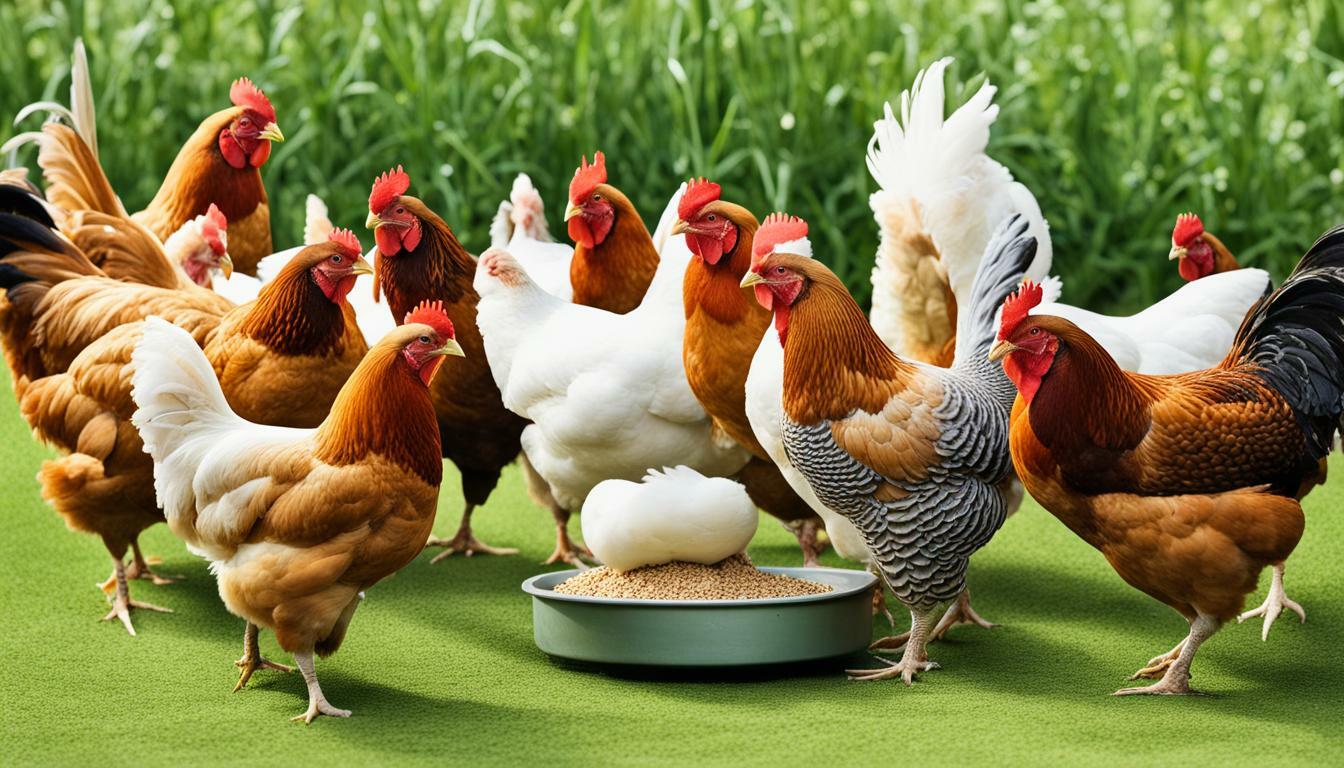As a poultry owner, you may wonder about your chickens’ feeding habits and whether they know when to stop eating. Chickens have instinctual eating patterns and a self-regulating appetite, but how do they signal satiety?
Understanding chicken behavior and their digestive system can help you provide proper nutrition for your flock and avoid overfeeding. In this article, we’ll explore the factors that influence food consumption in chickens and how to identify their satiety signals.
Key Takeaways:
- Chickens have instinctual eating patterns and a self-regulating appetite.
- Satiety signals in chickens include pecking less vigorously and wandering away from the food source.
- Factors that influence food consumption in chickens include age, breed, size, and activity levels.
- Proper nutrition is crucial for a chicken’s overall health and well-being.
Understanding Chicken Feeding Behavior
Chickens have instinctual eating patterns, which means they eat throughout the day. This behavior is due to their self-regulating appetite that allows them to eat only what they need.
Chickens have a natural tendency to peck for food, and it is essential to provide a balanced diet to ensure their well-being. They prefer a varied diet and will eat a combination of grains, seeds, vegetables, and insects if available.
As with most animals, water is also a critical component of a chicken’s diet. They require access to clean water at all times, and it is recommended to provide multiple sources throughout their living area.
Poultry Feeding Behavior
It is important to understand the feeding behavior of chickens to provide them with adequate nutrition. Chickens are opportunistic eaters and will consume as much food as available when food is scarce. On the other hand, when ample food is present, they will regulate their consumption to match their needs.
Chickens have the ability to self-regulate based on their appetite, and they signal their satiety levels. Owners should observe their chicken’s behavior because overfeeding can lead to obesity and health complications.
Instinctual Eating Patterns
Chickens have an instinctual eating pattern that goes back to their wild roots. In the wild, chickens would scavenge for their food and eat small amounts throughout the day. This behavior is still evident in domesticated chickens, making it essential to provide food throughout the day.
Understanding chicken behavior and feeding habits is crucial for their well-being. A balanced diet that incorporates their natural dietary needs is essential for their health and longevity.
How Chickens Signal Satiety
As you now know, chickens have a self-regulating appetite and are capable of controlling their food consumption based on their needs. But how do they communicate their satiety levels?
Satiety signals are behaviors or actions exhibited by chickens that indicate they’ve had enough to eat. One common signal is pecking less vigorously, where chickens become less enthusiastic about food and begin to pick at it instead of consuming it quickly. You may also observe chickens wandering away from the food source or engaging in other activities, such as preening or dust bathing.
It’s important to pay attention to these signals as overfeeding your chickens can lead to obesity and other health issues. Additionally, it’s essential to provide your flock with a balanced diet that meets their nutritional needs and doesn’t encourage overconsumption.
Understanding your chickens’ behavior and observing their satiety signals will help you establish healthy feeding practices and promote their overall well-being.
Factors Influencing Food Consumption in Chickens
When it comes to feeding chickens, understanding their feeding habits and behavior is crucial. While chickens are primarily self-regulating when it comes to their appetite, several factors can influence their food consumption.
Age
Chickens’ food intake needs vary by age. Younger chickens require more protein for growth, while older chickens require less. If you’re feeding chickens of varying ages, consider separating them to ensure they’re eating an appropriate amount.
Breed and Size
Not all chicken breeds are created equal. Some breeds have a larger appetite than others. Similarly, larger chickens will need more food than smaller chickens. It’s essential to consider the breed and size of your chickens when determining their daily food intake.
Activity Levels
Active chickens will burn more calories and require more food. If your chickens have plenty of room to roam and are free-range, they’ll need more food than those who are in a smaller coop.
Environmental Factors
Environmental factors such as temperature and stress can also affect a chicken’s appetite. Chickens tend to eat less when they’re too hot or too cold, and stressful situations can also impact their food intake. Ensure your chickens have a comfortable environment to encourage healthy eating habits.
By understanding the factors that can influence food consumption in chickens, you can ensure your flock is getting the appropriate amount of nutrition. Keep in mind that each chicken is an individual with unique needs, so pay attention to their habits and adjust their diet as necessary to promote their overall health and well-being.
The Chicken Digestive System
Understanding the chicken digestive system is essential for providing adequate nutrition to your flock. Chickens are omnivores, meaning that they can consume both plant and animal-based foods.
The chicken digestive system consists of several parts, including the crop, proventriculus, gizzard, small intestine, ceca, and cloaca. The crop is an enlarged part of the esophagus that allows chickens to store food temporarily. From the crop, food moves to the proventriculus, where digestive juices are added to break down the food. The gizzard is a muscular organ that grinds the food, utilizing small stones or grit for mechanical digestion. After the gizzard, the food moves to the small intestine where nutrients are absorbed. The ceca are blind pouches that harbor beneficial bacteria for fermentation, and finally, waste exits the chicken’s body through the cloaca.
It’s crucial to provide chickens with appropriate food types to support their digestive system. Feed that is too coarse or contains too much fiber may not break down adequately in the gizzard, leading to digestive issues. Similarly, feeding chickens too much food can overwhelm their digestive system, leading to crop impaction or other digestive problems. Understanding the chicken digestive system can help you avoid these issues and provide your flock with the appropriate nutrition they need to thrive.
Conclusion
Understanding chicken behavior and feeding habits is essential for any chicken owner who wants to ensure their flock’s health and well-being. Chickens are instinctual creatures with a self-regulating appetite, which means they know when to stop eating. By observing their satiety signals, you can prevent overfeeding and avoid potential health issues.
Factors such as age, breed, size, activity levels, and environment may also influence their food consumption. Ensuring you provide appropriate nutrition for your flock is crucial to their growth and development.
It’s also essential to consider the chicken’s digestive system when feeding them. Proper knowledge of their digestive tract and what foods to avoid can help prevent digestive issues and keep your flock healthy.
Overall, it’s essential to pay attention to your flock’s individual needs and establish healthy feeding practices. With the right care, your chickens will thrive and provide you with nutritious and delicious eggs for years to come.
Is a Dove the Same as a Pigeon?
The distinction between a dove and a pigeon lies in their anatomy, behavior, and symbolism. While they belong to the same family, Columbidae, there are distinct differences between dove and pigeon species. Doves are typically smaller, possess rounder bodies, and tend to symbolize peace and purity. Pigeons, on the other hand, often have larger bodies, exhibit different behaviors, and are sometimes associated with urban environments. Despite their differences, both birds share certain characteristics and provide valuable contributions to their ecosystems.
FAQ
Q: Do chickens know when to stop eating?
A: Yes, chickens have instinctual eating patterns and can self-regulate their appetite based on their needs. They have satiety signals that indicate when they have had enough to eat.
Q: What are the feeding habits of chickens?
A: Chickens tend to eat throughout the day, pecking for food as they come across it. They have a self-regulating appetite and will typically stop eating when they are satisfied.
Q: How do chickens signal satiety?
A: Chickens exhibit various behaviors when they have had enough to eat. They may peck less vigorously or wander away from the food source. It’s important to observe these signals to prevent overfeeding.
Q: What factors influence food consumption in chickens?
A: Factors such as age, breed, size, and activity levels can affect how much food chickens consume. Environmental factors like temperature and stress can also play a role in their food intake.
Q: How does the chicken’s digestive system work?
A: The chicken’s digestive system consists of various parts, including the crop, gizzard, and intestines. Food goes through a process of digestion to extract nutrients. It’s important to provide appropriate food types and avoid foods that may cause digestive issues.











